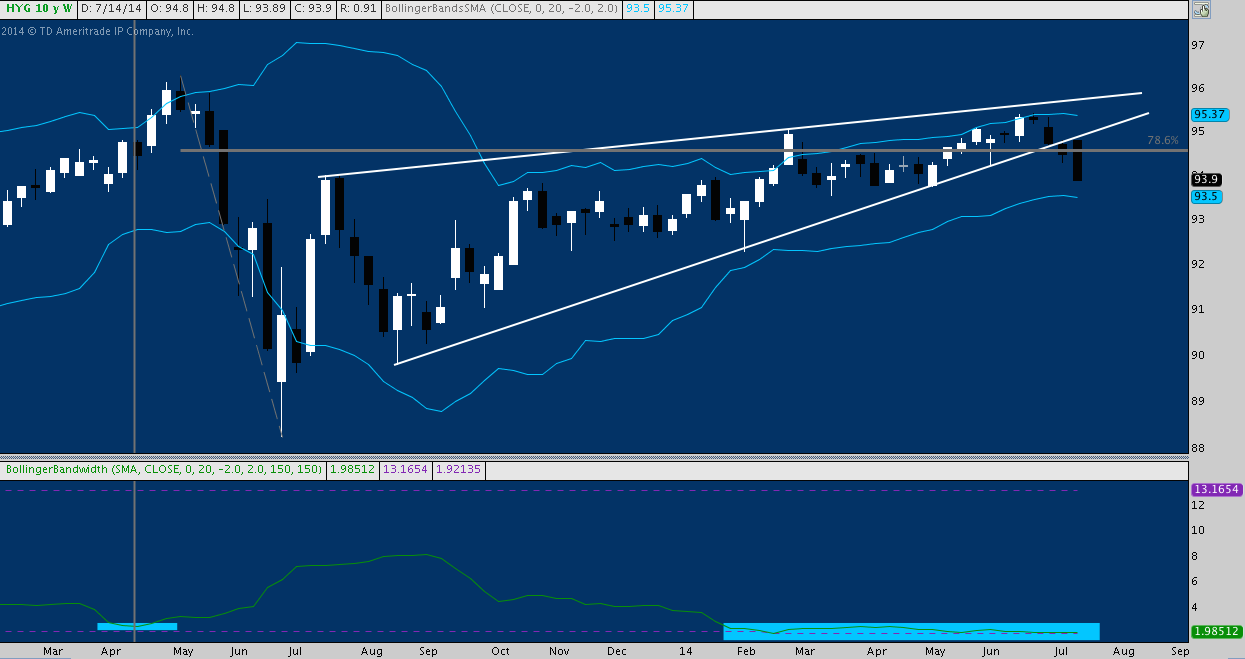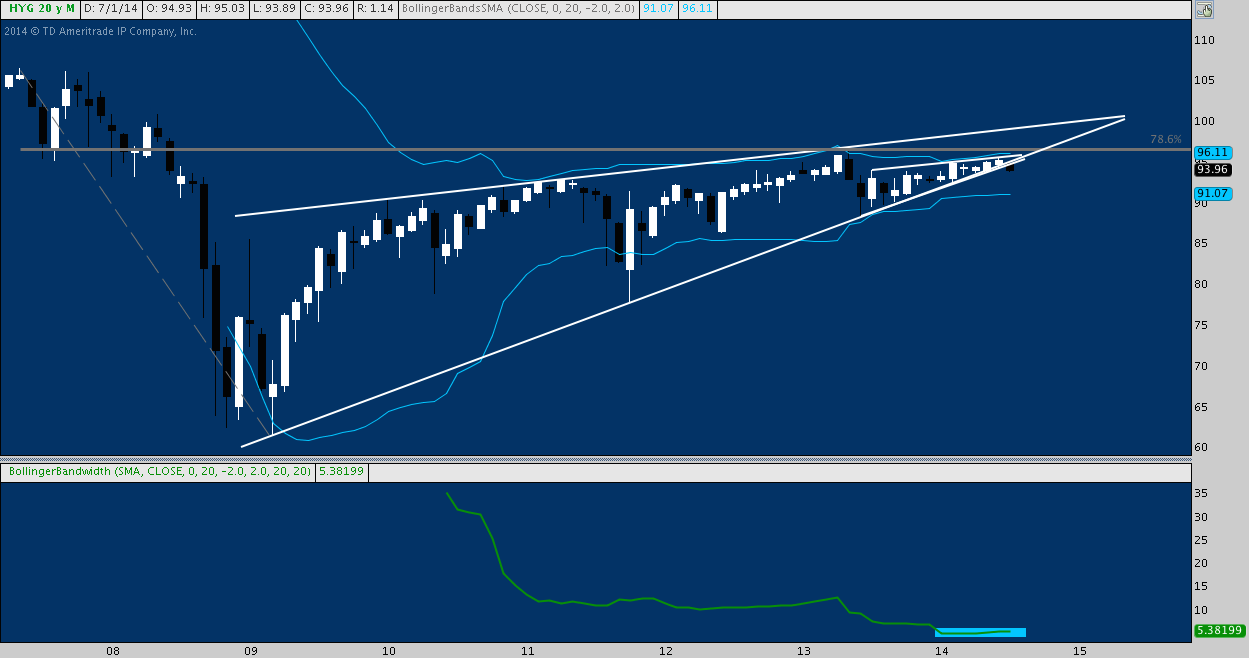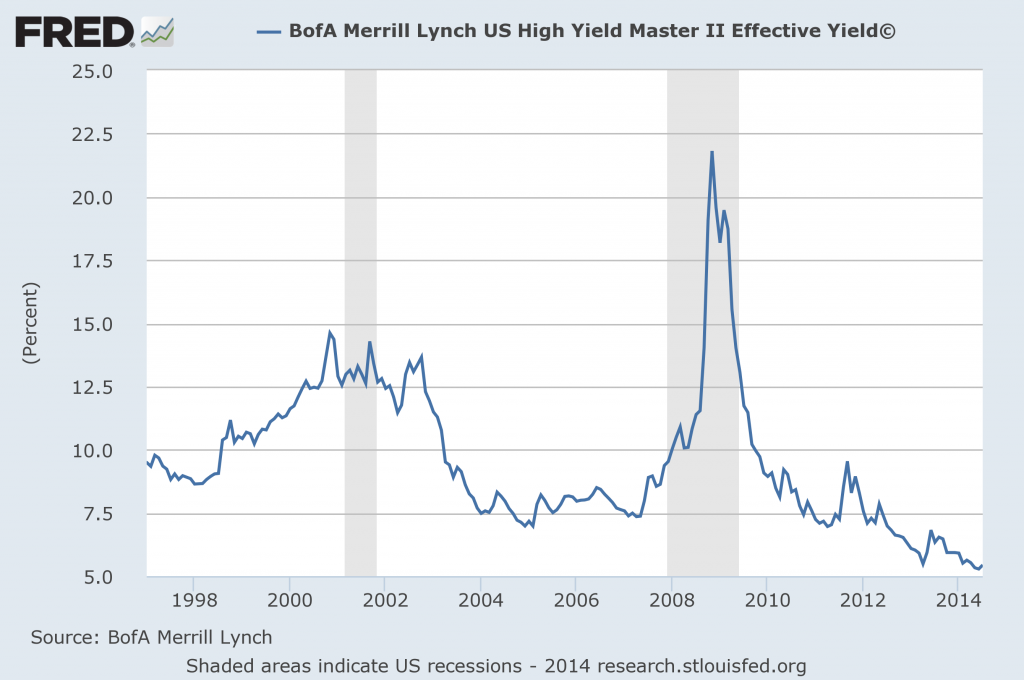“The Committee recognizes that low interest rates may provide incentives for some investors to “reach for yield,” and those actions could increase vulnerabilities in the financial system to adverse events. While prices of real estate, equities, and corporate bonds have risen appreciably and valuation metrics have increased, they remain generally in line with historical norms. In some sectors, such as lower-rated corporate debt, valuations appear stretched and issuance has been brisk.”
— Fed Chair Janet Yellen, July 15, 2014 — Semiannual Monetary Policy Report to the Congress Before the Committee on Banking, Housing, and Urban Affairs, U.S. Senate
Notice the ugly duckling.
The occasionally gaffe-prone Fed Chairmanwoman wasn’t pressed during her Congressional testimony this week into conceding or unwittingly divulging her view that US High Yield corporate debt is overvalued, even as a glut of supply (predicated on the accommodative policy she continues to advocate) has been brought to market. Quite to the contrary, Yellen carefully singled out domestic junk bond valuations as “stretched” from among the litany of asset classes she cited — all in her prepared remarks.
It appears markets are taking notice. The iShares High Yield Corporate Bond ETF (HYG) has been drifting lower since mid-June and nominally broke beneath it’s 12-month Rising Wedge last week. This follows the second failed attempt to hold above the 78.6% retracement of the range installed last year during the so-called Taper Tantrum that followed then-Fed Chairman Bernanke’s initial references to measured reductions in the the FED’s long-running LSAP/QE program. The action since then has been a corrective rally entirely inside the April-June 2013 range; and now High Yield is on-track for it’s worst weekly performance in a year as the rising wedge break confirms/presses lower even as HYG’s volatility remains poised to spring from it’s historically low levels (see Bollinger Bandwidth in bottom panel):
Yellen’s remarks aren’t the cause here – as we’ll see in a moment, High Yield has been sowing the seeds of a major sell off for years – but they may be catalyst. She is entirely correct, if (predictably) too tentative: High Yield valuations have been pushed to levels that are beyond any rational appraisal. If a great conflagration in junk begins here, her words won’t be the mountain of parched tinder piled up since early 2009; but it’s plausible that they’re the spark that triggers a broad and radical reassessment of allocation to speculative-grade debt.
Her veiled allusion to low rates providing “incentives for some investors to ‘reach for yield'” is perfectly disingenuous: to the degree the degree High Yield has become a Frankensteinian Monster, her institution is the mad scientist that has stitched it’s sinews together, pushed all the appropriate buttons and harnessed the animating powers of ZIRP lightning that have given it life. In fairness to her, no Fed chair has ever conceded fault – or could, really – armed as they are with full knowledge that Fed credibility is the sole vital principle behind effective monetary policy. To the degree she is capable, though, Yellen has admitted that the state of High Yield today is a product of the Fed’s policy engineering. Ever the pragmatists – in theory, if not in practice – the Fed may even believe that blowing a local bubble in speculative-grade corporate debt as they’ve fostered conditions compelling investors to take on more risk has been a necessary evil to stimulating a broad-based recovery. That explanation looks askance at the speculative fervor observed in other asset classes; but then again, Yellen feels equities, real estate and IG corporates are all fairly valued, though she notes prices have “risen appreciably” across the board.
But just how big is this creature that the Fed has designed? To understand the full scope of the thing the FOMC’s “incentives” has wrought, check out another wedge break underway right now:
If this chart looks just like the one above, it’s because they both feature: A) huge sell off, followed by B) strong W-bottom that incites a melt-up rally, eventually C) stalling into sideways movement at the 78.6% retracement and giving way to a D) long, simmering and every-tapering wedge formation. On closer inspection, you’ll note the 12-month wedge – a fractal pattern one magnitude smaller – presented in the first chart nestled way out at the tail-end of this wedge.
HYG’s 5.5-year rising wedge (arithmetic) is also breaking here, amidst the lowest volatility period in its (albeit relatively short) history. Whether that break will stick is up for debate – insert the usual “markets can remain irrational longer than…” caveat here – but the debate over where high yield prices are headed is already decided (see effective yield, below).
For many months the question at-issue has been when prices will begin to decline; and this wedge break may be the long-awaited answer.
Twitter: @andrewunknown and @seeitmarket
Author holds no exposure to instruments mentioned at the time of publication. Commentary provided is for educational purposes only and in no way constitutes trading or investment advice.










